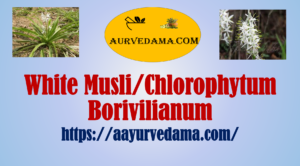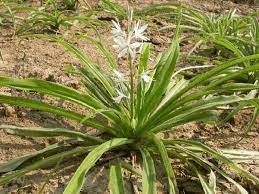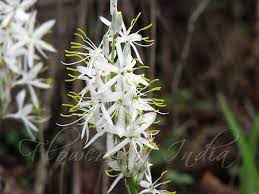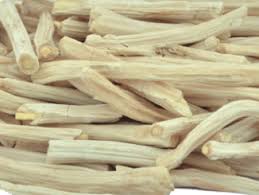White Musli/Chlorophytum Borivilianum
Medicinal plant White Musli/Chlorophytum Borivilianum is a tropical humid forest plant. It belongs to Asparagaceae family and its scientific name is Chlorophytum Borivilianum. White Musli also belongs to Asparagaceae family. White Musli is native to India and is found in the subtropical forests of the Himalayas and in the forests of the states of Assam, West Bengal, Karnataka, Tamil Nadu, Uttarakhand and Maharashtra. It is cultivated in Maharashtra as well as some other states due to its medicinal properties.

White Musli is a deciduous shrub 30–50 cm. grows tall. Its roots are long spread underground and their shape is oblong. The leaves are sessile and rarely short-stalked and seem to have arisen from the roots. Leaves 15–45 cm. long and 1·5–3·5 cm. are wide. They are spear-like in shape and are round. The tips of the leaves begin to touch the ground, which form adventitious roots and a new plant. Inflorescence is axillary and axillary. The flowers are small, white and drooping. The inflorescence has stamens at the top, while bisexual flowers at the bottom. In a flower with circular compound six petals, there are six pumangs attached to the peridalpunja. Anthers are longer than the stamens. The pistil is longer (larger) than the stamen and the pistil structure is opposite to the stamen. The ovary is jointed and erect. Kukshi is divided into three parts. The fruit is box type and contains four black, oblong and shiny seeds. The seeds have a fine notch like a beak.

Safed Musli is used in Ayurvedic medicine. Musli contains 25 types of alkaloids, vitamins, minerals, proteins (5–10%), carbohydrates (35–45%), fibers (20–30%), polysaccharides (40–45%) and saponins (2–15%). Saponin is an aphrodisiac and tonic and is used in many medicines. Safed Musli is choleretic, but expectorant. Its powder mixed with milk or honey and applied on the face brightens the face. Safed musli is prohibited to be carried like other common plants, as it is a forest produce and requires the permission of the Forest Officer.
Must Read – Amaranth ( Quinoa )

Benefits of White Musli/Chlorophytum Borivilianum
-
For fatigue and weakness:
White muesli with sugar (cane brown sugar) helps in reducing fatigue and gives strength to the body. -
For weight gain:
You can take it with milk to gain weight. -
For hypospermia:
It is very useful for treating hypospermia and improves count, volume, liquefaction time and motility. It also improves serum testosterone levels and testicular function. -
To treat insomnia:
If the patient feels weakness, pain in the back and lack of energy after emission at night, white musa powder with sugar should be used for a few weeks. This remedy helps in reducing the frequency of nocturnal emissions and regenerating the body. -
To treat erectile dysfunction:
It provides strength to the penile tissue, improves hardness, and helps in sustaining ejaculation for a long time. It primarily provides strength, acts on the testes, improves hormone profile, and induces spermatogenesis.
For arthritis and joint pain: - It has anti-inflammatory properties, which helps in reducing joint inflammation in arthritis
-
It helps improve mental health and combat stress and depression.
This herb for women can help in getting rid of vaginal dryness. - It is also useful for lactating mothers as it improves the quality of milk.
- It is also used as a health supplement for body building.
Also Read – Calotropis Gigantea
Side Effects of White Musli/Chlorophytum Borivilianum
- Although most of the side effects are uncommon and can be ignored, there are some side effects that may sometimes require medical attention.
- Excessive consumption of Safed Musli is not recommended. The fiber present in it reduces the moisture and hardens the stool. This, in turn, negatively affects bowel movement in the small intestine. You may experience a blockage in your gut, with constipation, cramping and pain.
-
Allergic reactions have been reported in many cases after consuming this vegetable. The most common allergic reactions include:
Eye swelling
runny nose
closed nose
Irritable and itchy throat
Itchy rings on the skin
Nausea
lightness
Dizziness
headache
Difficulty breathing
Source : Marathi विश्वकोश
Read More
